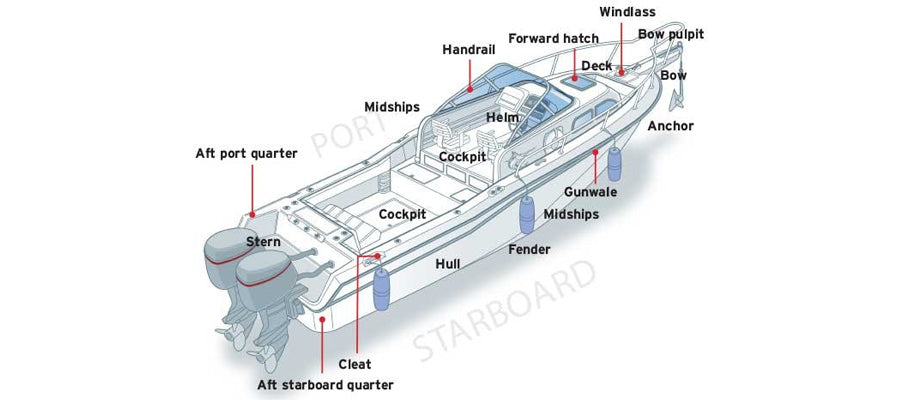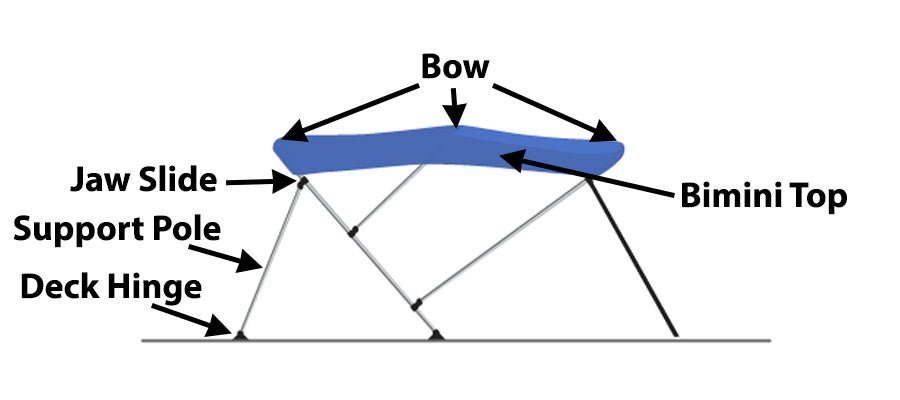Boating Vocabulary: Words Boaters Should Know

Boating has a long history and has played, and still does play, a crucial role in exploration, transportation, and recreation. With that kind of legacy comes a vast vocabulary developed to help people work and play in the marine environment. While there are entire dictionaries dedicated to boating terminology, here we will highlight some of the most important and common terms that most modern boaters should know.
Boating Terms

Illustration: BoatUS
Abeam
At a right angle to the centerline or keel of the boat, alongside the boat
Aft
A position closer to the stern or back of the boat
Amidships (Midships)
The center or central area of the boat
Beam
The widest part of the boat, the greatest width
Bow
The front or forward end of the boat, as opposed to the stern (mnemonic: “B” comes before “S” in the alphabet, just like the Bow of the boat comes before the Stern)
Bulkhead
A partition, usually structural, that separates compartments of a boat
Cabin
A main compartment, enclosed area, or living space for crew and passengers
Companionway
The set of steps or walkway that provides access from the deck to the below-decks areas of the boat
Console
A station to stand or sit at located on the deck which often contains the helm, an operator’s console
Deck
Usually the exterior flat surfaces of a boat that passengers and crew walk on, but can also refer to the levels of a vessel, as in “Deck 4”, which could be an interior or exterior level
Draft
The minimum depth of water a boat can float in, or the distance between the waterline and the bottom of the keel
Flybridge
A raised helm or navigation console, often above the cabin, from which the boat can be operated. It usually includes an area for entertaining or sitting as well
Freeboard
The vertical distance from the waterline to the lowest point at which water could enter the boat over the edge
Galley
The name for a boat’s kitchen
Gangway
A passage or ramp used to board or disembark a boat
Gunwale
The top edge of a boat’s sides
Hatch
A watertight cover or doorway in a boat deck or cabin top
Head
The name for a boat’s toilet
Heeling
The leaning of a sailboat as the wind pushes against the sails
Helm
A boat’s operating console, containing the wheel and engine controls
Hull
The body or shell of a boat that physically touches the water
Jib
The sail set forward of a sailboat’s masts and mainsail
Jibe
Steering a sailboat’s stern through the wind (as opposed to a tack)
Keel
The center ridge running bow to stern under a boat’s hull. In a sailboat the keel can run very deep to provide stability
Leeward
The same direction the wind is blowing (as opposed to windward)
Length Overall (LOA)
The length of a vessel from its farthest extent aft to its farthest extend forward including all attached tackle
Lifelines
Cables or lines running around a boat to prevent crew, passengers, or equipment from falling overboard
Locker
Any small compartment on a boat used for storage
Mainsail
The largest, main working sail of a boat attached to the main mast and controlled by a horizontal boom
Mast
A vertical pole that supports the sails of a sailboat
Point of Sail
The boat’s direction relative to the wind
Port
The left side of a boat when standing onboard, facing the bow (as opposed to starboard). Mnemonic: port has fewer letters than starboard just like left has fewer letters than right
Rudder
The vertical fin or plate at the back of a boat that extends into the water used for steering
Saloon
The main room for entertaining on a boat
Scuppers
Holes in the hull that allow water on the deck to drain overboard
Stanchion
Upright poles around a boat’s edge that support lifelines
Starboard
The right side of a boat when standing onboard, facing the bow (as opposed to port). Mnemonic: starboard has more letters than port just like right has more letters than left
Stem
The forward most part of the bow
Stern
The back, or aft area of the boat
Swim Platform
A water-level platform at the stern of the boat used to enter and exit the water easily
Tack
Steering a sailboat’s bow through the wind (as opposed to a jibe)
Tiller
The handle connected to the rudder or an outboard motor used for steering
Transom
The flat surface forming a boat’s stern
Trim Tabs
Plates on the stern bottom of a boat’s hull that can be adjusted to change the vessel’s attitude, pitch, and roll while underway
Waterline
The point up to which water rises on a boat’s hull
Windward
The direction from which the wind is blowing (as opposed to leeward)
Anchor Terms

Bill
The tip of an anchor’s fluke
Crown
The bottom of an anchor (as opposed to the head)
Eye
The hole in the shank where the anchor rode is connected
Fluke
The fins or scoops of an anchor that dig into the bottom and hold material
Head
The top of an anchor (as opposed to the crown)
Shank
The long bar running from head to crown that is the main appendage of an anchor
Stock
A bar that runs perpendicular to the shank
Tripping Ring
A hole or ring located near the crown of an anchor used to connect a tripping line for easier hauling
Windlass Terms

Capstan
The cylinder or drum on a windlass for winding rope
Clutch Lever
A handle used to tighten the clutch in such cases as the windlass is slipping when trying to haul the anchor
Gipsy
The cylinder or drum on a windlass for winding chain. Some gypsies can accept both chain and rope
Horizontal Windlass
A windlass that features a gypsy or capstan with a horizontal axis and the motor on the deck.
Vertical Windlass
A windlass that features a gypsy or capstan with a vertical axis and the motor under the deck.
Rope Terms

8-Plait
Also known as “square braid”, consists of eight individual strands that are woven in four pairs. Makes great anchor line and works well in most windlasses
Bow Line
A line tied from a boat’s bow to a point on the dock forward of the bow
Cleat
A T-shaped attachment point for boat lines
Double Braided
A braided rope core that is enclosed by a braided rope sleeve. Makes excellent dock and anchor line
Ground Tackle
The anchor, rope, chain, and accessories that make up a boat’s anchoring system
Halyards
A rope used for raising and lowering a sail on a sailboat
Mooring
Refers to a permanent anchorage with a buoy where a boat can tie up. It can also refer to a dock or pier where a boat ties up
Rode
A combination of rope spliced to chain generally used in windlasses for anchoring
Sheets
Control lines for operating sails on a sailboat
Splice
A woven connection between rope and chain in an anchor rode made so that the rode can feed through a windlass
Spring Lines
Dock lines secured such that a boat cannot shift forward and aft
Stern Line
A line tied from a boat’s stern to a point on the dock aft of the stern
3-Strand
Also known as twisted rope, a rope constructed of three individual strands twisted together. It is standard, inexpensive, anchor line or general-purpose rope
Fender Terms

Buoy
A spherical float or boat bumper
Center-Hole
Also known as HTM fenders, boat fenders with a hole through the middle lengthwise for securing the fender to a boat or dock
Dock Fender
A bumper, inflated or foam-filled, hung alongside a boat to prevent impact or abrasion against another vessel or dock
Double-Eye
A boat fender that has an eye or hole at each end with which it may be tied to a boat or dock
Flat
A foam-filled boat fender that is rectangular and flat, used most often to prevent impact or abrasion when rafting two boats together
Hole Through the Middle (HTM)
Also known as center-hole fenders, boat fenders with a hole through the middle lengthwise for securing the fender to a boat or dock
Ribbed
A boat fender that employs vertical ribbing for reinforcement
Wheel
An inflated or foam-filled boat fender constructed as a rotating wheel to fend a boat off dock or slip corners and walls while guiding it into its berth
Bimini Terms

Boot
A cover placed over a folded bimini top to protect it
Bow
A rib that supports the canvas on a bimini top
Deck Hinge
A connector that attaches bimini poles to the deck of a boat
Jaw Slide
A connector that attaches bimini poles to other bimini poles
Outside End
A connector that fits into a jaw slide or deck hinge
Support Pole
Also known as a rear support pole, attaches to the aft end of a bimini down to a boat’s deck or gunwales in order to keep a folded bimini raised and out of the way
Bimini Top
The canvas of a bimini
Published
Recent Posts
Windlass Problems? Common Issues and How to Fix Them

Let's look at common issues with windlasses and how to address them:
1) Windlass Won’t Run in Either Direction
2) Solenoid Clicks, but Windlass Won’t Move
3) Windlass Lacks Power to Haul the Anchor
4) Rode Gets Jammed or Doesn’t Come In
Our history: a 20 year journey

Boat Cleaning Tips for Anglers: Keeping Your Vessel Spotless and Pristine

Avast, Ye Mariners! Master the Art of Docking: A Swashbuckling Guide for Boaters

Top Reasons to Keep a Boating Maintenance Log

4 Top Tips for Buying a New-to-you Used Boat

Bent Boat Anchor Shank: Common Causes and Prevention Tips

Prepare Your Boat For An Above Average Hurricane Season

Best Methods For Anchoring Your Jet Ski in Deep or Shallow Water

Best Options For Connecting Your Boat To WiFi Internet
